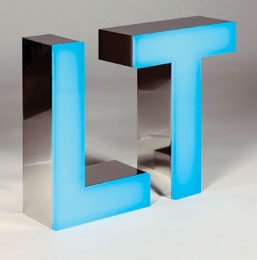I have the opportunity to see things many people in the industry do not. I am fortunate that my job responsibilities allow me unrestricted access to manufacturing facilities of sign companies throughout the U.S. and Canada.
My position has taken me inside the fabrication plants of nearly all the major players in the national program arena—Pattison, Architectural Graphics, Persona, Direct Sign Wholesale, Everbrite, Ruggles, SignTech, and Steel Art are just a small sampling of the companies whose operations I’ve toured and whose manufacturing processes, techniques, and procedures I’ve observed.
I’ve had the ability to interact personally with their manufacturing, design, and management teams to discuss how things are currently done and how they’d like to see things be done in the future.
Being in this somewhat unique position permits me the opportunity to quickly ascertain current trends in our industry, identify future trends in channel letter manufacturing, and predict what fabrication challenges are likely to confront manufacturers.
Whether the challenges relate to equipment, materials, or techniques, my primary task is to determine what can be done to take advantage of these trends, overcome the obstacles they present, and help manufacturers turn opportunity into additional, bottom line dollars.
While there are always numerous trends evolving in the signage industry at any given time, there are currently three rapidly growing trends in the channel letter industry, in particular, that have caught my attention: Channel letters and logos are trending towards being smaller, low profile, and trimless.
The driving force behind these trends is typically commercial property entities or corporate branding experts, architects, and designers. Ultimately these are the people specifying smaller, low profile, and/or trimless letters in airports, shopping centers, strip malls (or their storefronts), franchise operations, and restaurants. The goal is to present a clean, sophisticated, identifiable, yet distinctively unique, image for their brand or facility.
So how are companies responding to these trends and overcoming the challenges created by them in order to seize the opportunity to benefit financially?
The answer to this question is fairly simple: Companies are making significant investments in improved equipment, materials, processes, and techniques in channel letter fabrication.
For example, trimless channel letters have been fabricated for years, but the process typically required unsightly fasteners to be driven through the walls of the return into the edge of very expensive, thick acrylic.

By eliminating the notching and flanging function of the automated letter bending process, letters today are formed about 50 to 60 percent faster than returns for traditional face-lit can be processed.
Traditional trim cap, which is the weakest link in the chain durability-wise, is eliminated entirely with trimless material. Along with eliminating the trim cap material itself, the labor associated with measuring, notching, shaping, and gluing trim cap to acrylic faces is also eliminated.
Trimless letters also command a higher price due to their cleaner, more sophisticated appearance and the limited number of manufacturers with the ability to produce them.
A side benefit to these smaller, low-profile letters that is often overlooked is shipping and handling cost. These newer channel letters weigh less and take up less space so shipping costs are reduced significantly. The amount of packaging material needed to pack and ship the letters to their final destination is likewise reduced. All of this means lower costs for the manufacturer and the customer.
Sign manufacturers are also responding to the challenges presented by the trend of smaller, low-profile letters by investing in cutting-edge automated bending technology.
The automated channel letter machines sold ten to fifteen years ago were very expensive and unnecessarily huge. The output from these old-school, low-tech bending machines often resembled hieroglyphics more than finished letters and therefore required lots of additional hand forming.
These antiquated behemoths also produced about ten inches of waste per letter, resulting in huge piles of scrap (the value of which is roughly $.50 to $.60 per foot!).
Today there are automated benders available that are smaller, faster, substantially more accurate, and far more profitable to operate. These higher quality, precision-engineered machines incorporate such exacting tolerances that they can dramatically increase accuracy and nearly eliminate hand forming after the automated bending process is completed.
A few of the bending machines available today are even capable of producing exceptionally crisp, accurate results like serifs measuring 3/16-inch in challenging materials like 20-gauge polished stainless steel and .063-inch aluminum.
Thanks to huge improvements in LED technology, letters as small as one-inch-deep are now becoming common, whereas it was previously impossible to illuminate such shallow letters without shadows and hot spots.
Resin-faced channel letters have been available from manufacturers in Asia for a few years, however, those letters are not serviceable, and the LEDs are often entirely encased in resin, which causes heat to build up and, in turn, the resin to fail.
Currently there is technology available in the United States that allows manufacturers to build serviceable, resin-faced letters that only require a layer of resin measuring about 1/4-inch in thickness. This new method allows an air space between the resin and the LEDs to minimize heat buildup, which greatly enhances the performance and longevity of the letter in both interior and exterior applications.
Price competition for traditional reverse and trim cap style letters is increasingly intense. Margins on these commoditized products are under tremendous pressure and are being squeezed more than ever.
Manufacturers who embrace new methods, materials, and techniques are going to be the ones reaping the rewards offered by these new trends in the industry.
As the saying goes: “Lead, follow, or get left behind.”
By James Cross, SDS ChannelBender Series Product Manager for North America at Adams Tech.
All photos: Adams Tech











